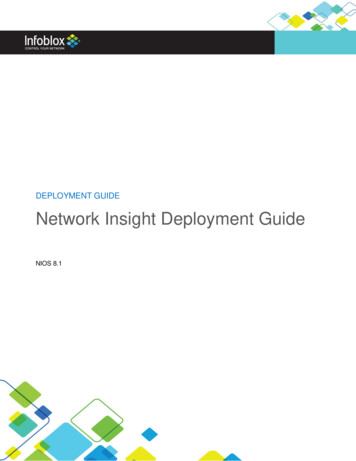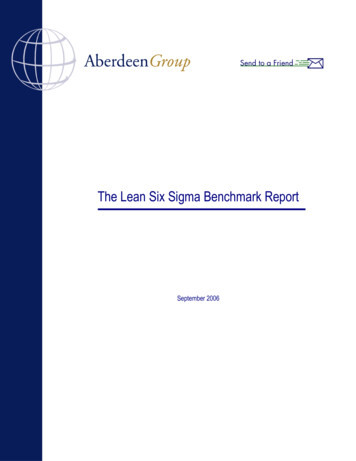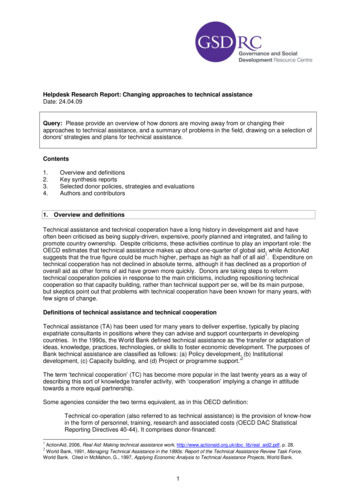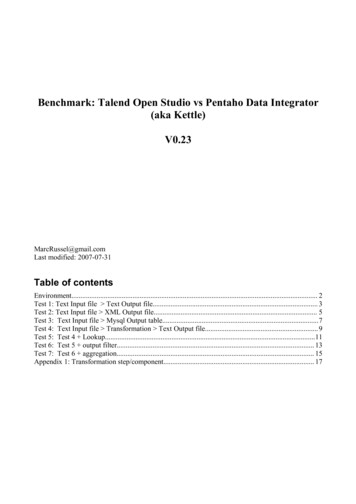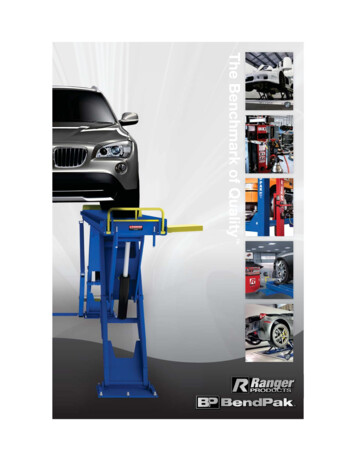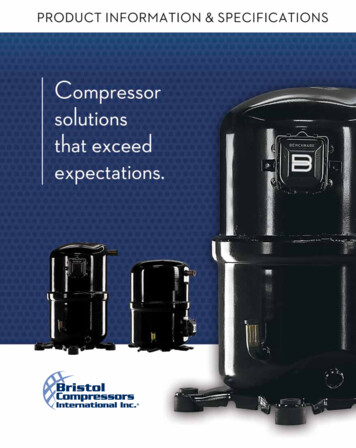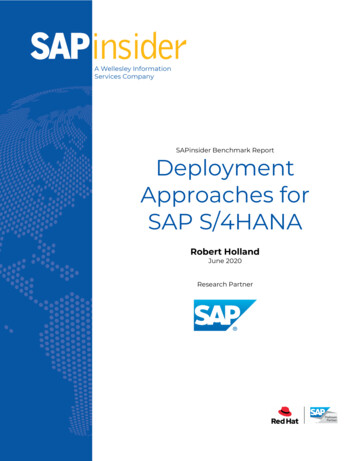
Transcription
SAPinsider Benchmark ReportDeploymentApproaches forSAP S/4HANARobert HollandJune 2020Research Partner
DEPLOYMENT APPROACHES FOR SAP S/4HANAResearch PartnerThe best-run businesses make the world run better. With courage,perseverance, and breakthrough technology, SAP customers tacklesome of the world's biggest challenges. Find out how they work withSAP to make a lasting difference – and learn about the technologysolutions that fuel their innovation.For more information, visit https://www.sap.comi SAPinsider Benchmark Report
DEPLOYMENT APPROACHES FOR SAP S/4HANTable of ContentsExecutive Summary . 1Required Actions . 4Chapter One: Deployment Approaches for SAP S/4HANAOverview. 5Best Practices Model – DART . 5What Drives SAP S/4HANA Deployment Approaches? . 7How Do Customers Meet Their Business Drivers?. 8Key Takeaways .9Chapter Two: How Do SAP Customers Approach theirSAP S/4HANA Deployment? . 11Top Requirements for SAP S/4HANA Deployment . 11Which Tools Do Respondents Use in Their SAP S/4HANADeployment? . 13Key Takeaways . 15Chapter Three: Required Actions . 17Steps to Success. 18Methodology . 20Appendix A: The DARTTM Methodology . 21i SAPinsider Benchmark Report
DEPLOYMENT APPROACHES FOR SAP S/4HANAExecutive SummaryDeploying SAP S/4HANA is an opportunity fororganizations to optimize their businessprocesses, reduce the cost of maintaining andadministering older hardware and infrastructure, andcreate a template for their business moving forward. Todo this successfully companies must evaluate allcomponents of their existing systems, especially anycustomizations or legacy processes, and carefullyconsider their SAP S/4HANA deployment options toensure they choose the best approach for them.In Q2 of 2020, SAPinsider surveyed 168 members of ourcommunity to understand their current plans for thedeployment of SAP S/4HANA, their progress so far, whatinfrastructure they intend to use, and what deploymentmodel they are using. Nearly two thirds (64%) ofrespondents said they have at least started evaluatingthe business case, while 39% have at least starteddeploying SAP S/4HANA. The most commondeployment model selected by respondents wassystem conversion (47%), closely followed by a newimplementation (41%) (see Figure 1). Only 12% ofrespondents said that they plan to use a selective datatransition as their deployment model.Figure 1: Planned deployment model for SAP S/4HANANewimplementation41%Systemconversion47%SAP S/4HANA andBW/4HANA provide thenext gen platform tobuild new, moreefficient processes thatwe simply can't deliverwith our currentarchitecture. Tacticallywe benefit fromimproved and moreefficient productallocations process viaAATP, improvedfinancial operations,simpler data structuresthat improve analyticsdelivery, andsignificantly improvedanalytics availability.Strategic benefitsinclude modernizingour SAP platform,allowing us to takemaximum advantage oftools like SAP CloudPlatform and SAPAnalytics Cloud. SAP Architecture Director,Beverage ManufacturerSelective datatransition12%Source: SAPinsider, June 20201 SAPinsider Benchmark Report
DEPLOYMENT APPROACHES FOR SAP S/4HANAWe also asked respondents what type of deploymentthey plan to use for SAP S/4HANA. Over half (53%) saidthey plan to use a standalone deployment, whileanother third (31%) said they plan to use a scaled-updeployment—one in which they were adding additionalresources to deliver increased performance. A smallerproportion (10%) of respondents said they intend to do ascaled-out deployment, where they anticipate beingable to accommodate horizontal scaling or a “pay-asyou-grow” infrastructure. The remainder of respondents(6%) are currently undecided on what approach theywould take.We also asked survey respondents how long theyexpect their deployment of SAP S/4HANA to take (notincluding the time needed to build the business case).The most common response (28%) was between 6 and12 months (see Figure 2), but on average respondentsexpect that their transition will take between 12 and 18months. A significant number (18%) said they expect thetransition to take more than 2 years, reflecting thecomplexity of the project.Figure 2: How long will your transition to SAP S/4HANAtake (not including building the business case)?30%25%20%15%10%5%0%Less than 6monthsBetween 6 and Between 12 and Between 1812 months18 monthsmonths and 2yearsMore than 2yearsSource: SAPinsider, June 2020The factors having the largest impact on respondents’transition timeline are: complexity of existing data2 SAPinsider Benchmark ReportWe are focusing theinitial migration asmore of a technicalupgrade with a fewoptimizations to helpminimize disruptions.We’ll focus changemanagement on thekey business enablersinitially and thencontinue the journey tofurther take advantageof the new capabilities. VP of IT, CPG Industry
DEPLOYMENT APPROACHES FOR SAP S/4HANAlandscapes (52%); the need to secure budget approval(46%); education/training of internal resources (43%);harmonization/cleansing of data from existing systems(42%); and that customized code needed to bereplaced/re-engineered (42%). A third (33%) ofrespondents stated that they saw external factors, suchas COVID-19, impacting their timeline.The survey revealed several other trends regardingrespondents' plans for their SAP S/4HANA deployment,including:3 Nearly half (49%) of respondents indicated thatthe COVID-19 crisis has impacted their cloudstrategy for SAP S/4HANA, and 65% said they areseeing an increased need to implement highavailability or disaster recovery options as a resultof the crisis. While 28% of respondents have no plans for acloud-based deployment of SAP S/4HANA and5% are still determining their strategy, 67% saidthat they are planning a cloud-baseddeployment. Of these, 43% said they plan todeploy in a private cloud (IaaS, SaaS, or Hybrid)environment, and 24% said they plan to deployin the public cloud. While Microsoft Azure (47%) remains the primaryplatform respondents look at when deployingSAP S/4HANA in a public cloud environment,Google Cloud (21%) is now ahead of AmazonWeb Services (18%). A majority of respondents (76%) said theirorganization’s infrastructure strategy hasdetermined their decision about where andhow they will deploy SAP S/4HANA to at leastsome extent. In some instances this forcedcloud-based deployments, while in others itprevented them. SAPinsider Benchmark Report
DEPLOYMENT APPROACHES FOR SAP S/4HANARequired ActionsBased on the responses that we received in the survey,organizations that are planning their deployment ofSAP S/4HANA should:4 Evaluate and understand what is required fortransition and what can be improved. Thereare many free tools offered by SAP and SAPS/4HANA implementation partners that will helporganizations understand their most criticaltasks for the deployment, and what canpotentially be improved. Utilize these tools to geta thorough understanding of potential issuesand determine your readiness for SAP S/4HANA. Standardization is key for leveraging industryspecific templates. In order to create a systemthat can be used as a template, it must beminimally customized—especially if it will beused in other regions. This is because only astandardized system can easily adapt to differentindustry and governmental requirements ineach region. Build a business case around digitaltransformation. Read the SAPinsider researchreport Building the Business Case for SAPS/4HANA to learn how other members of theSAPinsider Community are focusing on digitaltransformation as they move towards adeployment of SAP S/4HANA. Leverage automation tools to reduce projectcost. While factors like infrastructure and licensecosts are already determined by the time SAPS/4HANA is deployed, taking actions toautomate tasks like data loading and validationand system testing can help reduce the timeneeded for the deployment, and allow valuableresources to focus on the most critical tasks. SAPinsider Benchmark Report
DEPLOYMENT APPROACHES FOR SAP S/4HANAChapter One:Deployment Approaches forSAP S/4HANA OverviewWhen deciding how they will deploy SAP S/4HANA,SAPinsiders need to determine which approach is the bestfit for their company’s situation. While some of thesedecisions are likely to be addressed during the creation ofthe business case, many specific details will still need to bedetermined following that stage. An organization’s uniquedeployment approach should be closely aligned withbroader business strategies, such as the infrastructurestrategy, in order to ensure that the SAP S/4HANAdeployment can leverage the benefits of those existingplans. Achieving this alignment will help generate a largerpositive return on investment more quickly than an isolateddeployment would achieve.Best Practices Model – DARTSAPinsider grounds all our research insights in ourproprietary DART model. This research model providespractical insights that connect business Drivers and Actionsto supporting Requirements and Technologies. Driversrepresent internal and external pressures that shapeorganizational direction. Organizations take Actions toaddress those Drivers. They need certain people, processes,and capabilities as Requirements for those strategies tosucceed. Finally, they need enabling Technologies to fulfilltheir Requirements.In this report, the need to optimize processes bymodernizing IT infrastructure (such as moving to SAPS/4HANA), pressure to lower total cost of ownership (TCO)and IT maintenance costs, and the need to harmonizeregional processes into one global template emerged as thekey business drivers. To satisfy these drivers, respondentsindicated that they are taking actions to implementstandardized end-to-end processes for core ERP users,deploy SAP S/4HANA with the approach that bestminimizes cost, preserve only operationally necessary5 SAPinsider Benchmark ReportThe process ofimplementing SAPS/4HANA goes througha lot of testingscenarios. Having ateam doing therequired testing,reviewinginfrastructure, addingcapacity, etc. is veryimportant. They ensurethat what is currentlybeing implemented hasbeen exhaustivelytested. They do all thediligent testing toensure that the securityand infrastructure isconfigured inaccordance with ourneeds. Senior Project Manager,Global Manufacturer
DEPLOYMENT APPROACHES FOR SAP S/4HANAcustomization to the core ERP, and set up and implementSAP S/4HANA in a flexible way to adapt to unpredictablemarket conditions in the long-term future.In order to succeed in their SAP S/4HANA deployments,respondents know that they need to minimally disruptoperations, implement a fully compliant system thatsupports both local and global regulations, improve datacleansing, management, and governance, ensure that theirERP is harmonized and centralized throughout theenterprise, and provide a detailed impact analysis onexisting custom code, business processes, and operationscosts. Respondents use or plan to use a wide range of SAPand partner tools and platforms to support theserequirements approaching their SAP S/4HANA deployment.Respondents’ answers to our survey and interviewquestions revealed clear trends, which are summarized inTable 1 and will be examined throughout this report.Table 1: DART model framework for deployment approachesfor SAP S/4HANADriversActions The move to SAP S/4HANA Implementing standardized end-toopens new opportunities toend processes for core ERP usersoptimize processes (61%)(51%)Requirements Minimal disruption tooperations (69%)Technologies Tools and services to analyzecustom code (82%) Pressure to lower TCO and Deploying SAP S/4HANA with theIT maintenance costs (30%)approach that minimizes cost (51%) Fully compliant system thatsupports both local andglobal regulations (48%) Advanced, predictive, andembedded analytics (81%) The need to harmonize Preserving only operationallyregional processes into onenecessary customization to the coreglobal template (22%)ERP (40%) Improved data cleansing,management, andgovernance (43%) Setting up and implementing SAPS/4HANA in a flexible way to adapt tounpredictable market conditions inthe long-term future (33%)6 SAPinsider Benchmark Report Virtualization or hyperconverged infrastructure(77%) Automated SAP S/4HANA Harmonized and centralizedtesting solution (75%)throughout the enterprise SAP S/4HANA architectural(40%)modeling tools (73%) Detailed impact analysis on Robotic process automationexisting custom code,(RPA) for data migrationbusiness processes, and(70%)operations costs (37%) Open sourceplatform/operating system(68%)
DEPLOYMENT APPROACHES FOR SAP S/4HANAWhat Drives SAP S/4HANADeployment Approaches?Nearly two thirds (61%) or respondents indicated that theprimary driver for SAP S/4HANA deployment was that thetransition opened new opportunities to optimize processeswith a business focus on digital transformation.Approximately half as many respondents (30%) said that thepressure to lower total cost of ownership (TCO) and ITmaintenance costs was the second most important driver(see Figure 3). The third factor driving the SAP S/4HANAdeployment was respondents’ need to harmonize regionalprocesses into one global template (22%).Figure 3: Top drivers for deploying SAP S/4HANA70%60%50%40%30%20%10%With SAP S/4HANA it ispossible to use an activemethodology andidentify the industrybest practices. Movingaway from what wasused previously, thisdefines what optimalprocesses are using astandard methodologyand framework. Insteadof doing fit-to-gap, usea fit-to-standardapproach which can beadopted very quickly bythe business teams whocan immediately seethe value.0%The move to SAP S/4HANA Pressure to lower totalopens new opportunities cost of ownership (TCO)to optimize processes and IT maintenance costsThe need to harmonizeregional processes intoone global templateSource: SAPinsider, June 2020Having the opportunity to redesign and optimize existingbusiness processes can offer significant performance andcost benefits for organizations. Respondents indicated thatthe primary measurements they will use to determine thesuccess of their SAP S/4HANA deployment include theincreased productivity (64%) and increased businessprocess efficiency (67%) of their business processes.To achieve improvements in these areas, organizationsneed to optimize their processes, an exercise that canimpact another factor driving SAP S/4HANA deployment—7 SAPinsider Benchmark Report Ajit Attavar,Global Program Director,Neptune Products &Services
DEPLOYMENT APPROACHES FOR SAP S/4HANAlowering TCO and IT maintenance costs. Existing ERPsystems can be expensive to maintain from aninfrastructure perspective due to aging hardware and as aresult of customized systems and processes that requirededicated administrative and support resources. Outdatedhardware and customized systems represent a technicaldebt that contributes to increased operating and ITmaintenance costs. Moving to a new infrastructure,particularly in the cloud, can reduce those costs, while amove to optimized standardized systems can contribute toreducing the cost of ongoing code maintenance.How Do Customers Meet TheirBusiness Drivers?Just over half of survey respondents (51%) indicated that themain action they are taking to address their drivers is toimplement standardized end-to-end processes for core ERPusers (as seen in Figure 4). Implementing standardizedprocesses will open more opportunities to optimize thoseprocesses and will also allow organizations to more readilyharmonize those processes into a global template. This isbecause it is much easier to create a template fromstandardized processes than customized ones.Figure 4: Top strategies prioritized to address the topdrivers of change60%50%40%30%20%10%0%ImplementingDeploying SAPPreserving onlySetting up andstandardized end-to- S/4HANA with theoperationallyimplementing SAPend processes forapproach thatnecessaryS/4HANA in a flexiblecore ERP usersminimizes cost customization to the way to adapt tocore ERPunpredictablemarket conditions inthe long-term futureSource: SAPinsider, June 20208 SAPinsider Benchmark Report
DEPLOYMENT APPROACHES FOR SAP S/4HANAAdditionally, 50.5% of respondents said that they areworking to deploy SAP S/4HANA with an approach thatminimizes cost. This cost-saving approach directly connectsto the pressure to lower TCO and IT maintenance costs anddemonstrates that organizations understand the expenseassociated with an SAP S/4HANA deployment. It makessense, then, that these organizations are looking for ways tooffset such a significant investment by minimizingexpenses across the board as they approach thedeployment itself, including costs associated with softwarelicenses, infrastructure, operations, and staffing.Survey respondents are also seeking every opportunity tooptimize processes, as evidenced by 40% saying they arepreserving only customizations that are operationallynecessary to their core ERP. Reducing the number ofcustomizations in the system by eliminating all but themost critical will help organizations meet their businessobjectives in multiple ways, including reducing TCO and ITmaintenance costs for SAP S/4HANA once it is deployed,and making it easier to turn the system into a harmonizedglobal template when additional instances of SAP S/4HANAare deployed across the organization.The final top strategy, selected by a third of respondents(33%), is that of setting up and implementing SAP S/4HANAin a flexible way so the system can adapt to unpredictablemarket conditions in the long-term future. Looking foropportunities to move away from the technical debt of theirolder systems has always been a reason to transition to SAPS/4HANA. As a result of the current global pandemic,however, large proportions of respondents are reexaminingtheir infrastructure, high availability, and disaster recoverystrategies. This reexamination supports all the main driversfor deployment, as well as the focus on digitaltransformation, which 53% of respondents say is the majordriver behind their SAP S/4HANA business case.Key TakeawaysBased on our research with respect to deploying SAPS/4HANA, the following takeaways are clear: 9Leverage opportunities for process optimization.Deploying SAP S/4HANA offers the SAPinsiderCommunity the opportunity to re-evaluate and SAPinsider Benchmark ReportAs part of the migrationwe needed to decide ifit was easier to revert tostandards, or better tomigrate the as-isprocess. Even though,from a technical designperspective, the tablesdon’t exist in SAPS/4HANA anymore it isstill possible to makethe minimal changes toget the processesworking and then dothe simplificationproject later. Team Lead, SAP CCoE,Global Retailer
DEPLOYMENT APPROACHES FOR SAP S/4HANAredesign processes that may have gone unchangedsince their current ERP system was originallyimplemented. While the largest proportion ofrespondents are planning a system conversion,simply having to adapt to standardized processesavailable in SAP S/4HANA offers the potential tooptimize processes and demonstrate value quickly.10 Focus on a system that harmonizes and centralizesregional processes. When building a financialsystem, 42% of respondents in our SAP S/4HANAFinance report said they are taking action to create asingle source of truth for their financial data, and 59%have a requirement for a centralized financial systemthat delivers visibility and control over all financialdata and processes. These requirements have carriedover to organizations’ planned deployment of SAPS/4HANA as they are looking to combine data frommultiple legacy systems to leverage the features andbenefits of the solution. Utilize tools to determine the most used andcritical processes and customizations. SAP and SAPS/4HANA implementation partners offer tools thathelp monitor code and business process use andperformance. Leverage these tools to understandusage levels and ensure that only the most neededprocesses and customizations are moved into thenew deployment. Set up a standardized system to provide moreflexibility. The SAPinsider Community has beenforced to make significant adjustments to systems,operations, personnel, procedures, and more in orderto adjust to the impacts caused by the COVID-19outbreak. Using cloud-based deployments orvirtualization solutions to provide infrastructureflexibility when deploying SAP S/4HANA, and limitingprocess customizations to create processstandardization, will allow for changes to operationalmodels to be made more easily and will provide asystem that has greater capabilities to adapt tofluctuating and unpredictable business demands. SAPinsider Benchmark Report
DEPLOYMENT APPROACHES FOR SAP S/4HANAChapter Two: How Do SAPCustomers Approach their SAPS/4HANA Deployment?Deploying SAP S/4HANA requires not only IT teamsmanaging the technical aspects of the deployment (eitherinternally or with the assistance of deployment partners),but also necessitates a commitment from business teamsto verify data, provide input on new or refined processes,and determine whether the system is providing accuratedata. This chapter explores how respondents prioritized thedifferent requirements and capabilities that theirorganizations needed to deploy SAP S/4HANA, and thetools that they used to support those requirements.Top Requirements forSAP S/4HANA DeploymentRespondents to the survey selected minimal disruption tooperations as the top requirement for their SAP S/4HANAdeployment, with 69% indicating that this was mostimportant to their success (see Figure 5).Figure 5: Top requirements for SAP S/4HANAdeployment successHaving business teamsactively engaged in theprocess is critical asthey are able to providevery detailed feedbackon each step and gap asit comes up so that itcan be addressedquickly. They need to bebatting for the IT anddeployment teams tomake the process gosmoothly. But it can alsobe really exciting for thebusiness as they can seethe minimal viableproduct very quicklyand see the benefits itbrings.80%70% Ajit Attavar,Global Program Director,Neptune Products &Services60%50%40%30%20%10%0%Minimaldisruption tooperationsFully compliant Improved data Harmonized and Detailed impactsystem thatcleansing,centralizedanalysis onsupports both management, throughout the existing customlocal and global and governanceenterprisecode, businessregulationsprocesses, andoperations costsSource: SAPinsider, June 202011 SAPinsider Benchmark Report
DEPLOYMENT APPROACHES FOR SAP S/4HANABusiness interruptions were identified as one of the top fivecost drivers impacting those who were putting together thebusiness case for SAP S/4HANA, and this requirement iscritical for the deployment phase as well. Ensuring thatthere are minimal disruptions to operations supports thedrivers for increased business process efficiency and thepressure to lower total cost of ownership (TCO). It alsosupports the action of deploying SAP S/4HANA with anapproach that minimizes cost, because businessinterruptions have cost implications beyond deployment.The second most important requirement selected byrespondents was that of having a fully compliant systemthat supports both local and global regulations (48%). Whilemany organizations have benefited from the flexibility thatthe customizations to their existing ERP systems haveoffered, this has frequently prohibited them fromperforming regular version and system upgrades, which inturn has prevented them from having a fully compliantsystem. Deploying SAP S/4HANA and minimizingcustomizations will help organizations meet compliance.Other top requirements include the need for improved datacleansing, management, and governance (43%), having asystem that is centralized and harmonized throughout theenterprise (40%), and performing a detailed impact analysison existing custom code, business processes, andoperations costs (37%). Data harmonization has come upregularly as a topic of concern for those transitioning to SAPS/4HANA, particularly because of the table structurechanges required from existing ERP systems, but alsobecause many organizations plan on integrating data frommultiple existing systems into a single SAP S/4HANAinstance. Additionally, data harmonization is required ifSAPinsiders are to have a centralized and harmonizedERP system.12 SAPinsider Benchmark ReportWe are still running anECC 6.0 systemimplemented in themid-2000s, and haveoften had to implementbespoke functionality tosupport processchanges that werestandard in laterproduct versionsbecause the cost of theupgrade was too highto be justified. Nowthere is a much betterway of doing things andwe can have newfunctionality like Aribaintegration andprocure-to-pay as agoal. Team Lead, SAP CCoE,Global Retailer
DEPLOYMENT APPROACHES FOR SAP S/4HANAWhich Tools Do Respondents Use inTheir SAP S/4HANA Deployment?A majority of respondents (82%) said they either use or planto use tools and services to analyze custom code (seeFigure 6). This feedback supports the requirement thatdeployment teams need to completely understand existingcode customizations and how those customizations mightbe migrated. Whether the tools being used are like SAPReadiness Check or those provided by partners specializingin SAP S/4HANA transitions, they help SAPinsidersunderstand what is needed to move their existing code intoan SAP S/4HANA deployment. Being able to analyze customcode also enables organizations to fully define theirdeployment roadmaps and avoid operational disruption byensuring they do no miss any steps in the process.Figure 6: Popular technologies included in deploymentapproaches for SAP S/4HANA90%80%70%60%50%40%30%20%10%0%Tools andAdvanced,Virtualization or Automated SAP SAP S/4HANAservices topredictive and hyper-converged S/4HANA testing architecturalanalyze customembeddedinfrastructuresolutionmodeling toolscodeanalyticsCurrently useImplementingEvaluating/Aware of needSource: SAPinsider, June 2020As they move to SAP S/4HANA, most respondents (81%) arelooking to use advanced, predictive, and embeddedanalytics. Having tools and technologies that provide insightinto data in their ERP systems is critical to be able to steer apath through disruptions caused by the COVID-19 crisis.Gaining these data insights is also something that cannotbe successfully achieved without meeting the requirement13 SAPinsider Benchmark ReportRPA for DataMigration
DEPLOYMENT APPROACHES FOR SAP S/4HANAfor improved data cleansing, management, andgovernance, as well as implementing standardized end-toend processes for core ERP users. This is because predictiveanalytics work best in standardized systems.Nearly one-third of respondents (29%) said they are alreadyusing virtualized infrastructures, which provide greaterenvironmental flexibility, whether implementing onpremise or in the cloud. An additional 48% of respondentssaid they are either implementing virtualization solutions orare aware of the need to do so. Virtualization solutions alloworganizations to potentially lower TCO and IT maintenancecosts by providing scalability even on existing infrastructure,as well as providing adaptability for future unpredictability.Survey responses demonstrated that those deploying onpremise are most likely to be using VMware vSphere (54%),and those using cloud-based virtualization options mostlyplan to use Microsoft Azure/VMware Services (53.5%).In order to accelerate their migration, 75% of respondentssaid they are using, installing, or are aware of the need forautomated SAP S/4HANA testing solutions. Many SAPpartners offer solutions in this space, and SAP S/4HANACloud offers a test automation tool that is available inquality environments. The biggest advantage of automatedtesting tools is that they can be configured to performchecks at each step of the process following the installationand configuration, such as data load, period close, andmonthly report generation, relieving the need for theseitems to be manually reviewed.Other key technologies that respondents plan to use as partof their SAP S/4HANA deployment include architecturalmodeling tools (73%), robotic process automation (RPA) fordata migration (70%), and open source platforms andoperating systems (68%).14 SAPinsider Benchmark ReportAutomated testingsolutions save us a lot oftime as they haveparameters already setup so that we don’thave to build themmanually. We use themfor normal scenariotesting like bookingentries, and to makesure that everythingrequired by connectedsystems is present. Weare also planning to usethem to create massiveentries automatically. Senior Project Manager,Global Manufacturer
DEPLOYMENT APPROACHES FOR SAP S/4HANAKey TakeawaysWhen it comes to equipping organizations with thecapabilities and technologies required for an effective SAPS/4HANA deployment:15 Work to minimize operational disruptions duringthe transition. Respondents ranked avoidingdisruptions to operations as the m
Figure 1: Planned deployment model for SAP S/4HANA Source: SAPinsider, June 2020 New implementation 41% Selective data transition 12% System conversion 47% D SAP S/4HANA and BW/4HANA provide the next gen platform to build new, more efficient processes that we simply can't deliver with

